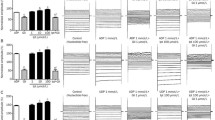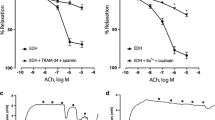Abstract
ATP-sensitive K+ channels (KATP channels) in the kidney have been found in the tubular system and in the afferent arteriole. In this study we have examined the binding of [3H]-P1075 ([3H]-N-cyano-N′-(1,1-dimethylpropyl)-N″-3-pyridylguanidine), a selective opener of KATP channels, in rat glomerular preparations.
Equilibrium (saturation, competition) and kinetic experiments indicated that [3H]-P1075 binds to a single class of sites with a dissociation constant of about 3 nM and a maximum binding capacity of 10 fmol mg−1 glomerular protein. The association rate constant of the complex was 6,5×107 M−1 min−1; dissociation occurred with a half-time of 6.2 min. Specific [3H]-P1075 binding was strongly reduced when the metabolic state of the glomerular preparation was impaired during the preparation procedure or the binding assay or when the preparation was subjected to mild collagenase treatment. In different metabolically competent preparations, the amount of specific [3H]-P1075 binding correlated well with the number of vascular endings adherent to the glomeruli; no specific binding was found in mesangial cells in culture. Specific [3H]-P1075 binding was inhibited by representatives of the different classes of KATP channel openers and by sulphonylureatype blockers with inhibition constants similar to those obtained in rat aortic rings.
It is concluded that rat glomerular preparations possess specific binding sites for KATP channel openers with vascular characteristics. The sensitivity of binding to mild collagenase treatment suggests that these sites are located on a membrane protein; in addition, the data suggest that these sites are localized on smooth muscle and/or renin secreting cells of the afferent vascular endings attached to some of the glomeruli. Their estimated density (1,500 μm−2) is much higher than that of KATP channels in smooth muscle.
Similar content being viewed by others
References
Affolter H, Hertel C, Jaeggi K, Portenier M, Staehelin M (1985) (−)S-[3H]CGP-12177 and its use to determine the rate constants of unlabelled beta-adrenergic antagonists. Proc Natl Acad Sci USA 82:925–929
Allard B, Lazdunski M, Rougier O (1995) Activation of ATP-dependent K+ channels by metabolic poisoning in adult mouse skeletal muscle: role of intracellular Mg2+ and pH. J Physiol 485:283–296
Ashcroft SJH, Ashcroft FM (1990) Properties and functions of ATP-sensitive K+ channels. Cell Signals 2:197–214
Bevington PR (1969) Data reduction and error analysis for the physical sciences. McGraw-Hill, New York, pp 55–65 and 92–118
Bray KM, Quast U (1992) A specific binding site for K+ channel openers in rat aorta. J Biol Chem 267:11689–11692
Della Bruna R, Pinet F, Corvol P, Kurtz A (1991) Regulation of renin secretion and renin synthesis by several messengers in isolated mouse juxtaglomerular cells. Cell Physiol Biochem 1:98–110
Draper NB, Smith H (1981) Applied regression analysis. Wiley, New York, pp 85–96 and 458–517
Edwards G, Weston AH (1993) The pharmacology of ATP-sensitive K+ channels. Annu Rev Pharmacol Toxicol 33:597–637
Edwards G, Weston AH (1994) Effect of potassium-channel modulating drugs on isolated smooth muscle. In: Szekeres L, Papp JG (eds) Handbook of experimental pharmacology, vol III. Springer, Heidelberg, pp 469–531
Ferrier CP, Kurtz A, Lehner P, Shaw SG, Pusterla C, Saxenhofer H, Weidmann P (1989) Stimulation of renin secretion by potassium channel activation with cromakalim. Eur J Clin Pharmacol 36:443–447
Garrino MG, Schmeer W Nenquin M, Meissner HP, Henquin JC (1985) Mechanism of the stimulation of insulin release in vitro by HB699, a benzoic acid derivative similar to the non-sulphonylurea moiety of glibenclamide. Diabetologica 28:697–708
Guillemare E, Honoré E, de Weille J, Fosset M, Lazdunski M, Meisheri KD (1994) Functional receptors in xenopus oocytes for U-37883A, a novel ATP-sensitive K+ channel blocker: Comparison with rat insulinoma cells. Mol Pharmacol 46:139–145
Guillemare E, Lazdunski M, Honore E (1995) Glibenclamide opens ATP-sensitive potassium channels in xenopus oocyte follicular cells during metabolic stress. Mol Pharmacol 47:588–594
Hackenthal E, Paul M, Ganten D, Taugner R (1990) Morphology, physiology, and molecular biology of renin secretion. Phys Rev 70:1067–1116
Inagaki N, Gonoi T, Clement IV JP, Namba N, Iazawa J, Gonzales G, Aguilar-Bryan L, Seino S, Bryan J (1995) Reconstitution of IKATP: An inward rectifier subunit plus the sulfonylurea receptor. Science 270:1166–1170
Kamouchi M, Kitamura K (1994) Regulation of ATP-sensitive K+ channels by ATP and nucleotide diphosphate in rabbit portal vein. Am J Physiol 266:H1687-H1698
Koushanpour E, Kriz W (1986) Renal physiology: principal, structure, and function, 2nd edn. Springer, New York
Linseman DA, Lawson JA, Jones DA, Ludens JH (1995) Glyburide attenuates calmodulin antagonist-stimulated renin release from isolated mouse juxtaglomerular cells. Am J Physiol 269:17242–17247
Manley PW, Quast U, Andres H, Bray KM (1993) Synthesis of and radioligand binding studies with a tritiated pinacidil analogue: Receptor interactions of structurally different classes of potassium channel openers and blockers. J Med Chem 36:2004–2010
McNicholas CM, Guggino WB, Schwiebert EM, Hebert SC, Giebisch G, Egan ME (1996) Sensitivity of a renal K+ channel (ROMK2) to the inhibitory sulfonylurea compound, glibenclamide, is enhanced by co-expression with the ATP-binding cassette transporter CFTR. Proc Natl Acad Sci USA (in press)
Means GE, Feeney RE (1971) Chemical modification of proteins. Holden Day, San Francisco, pp 105–110 and 218–219
Meisheri K, Fosset M, Humphrey S, Lazdunski M (1995) Receptor binding characterization in kidney membrane of [3H]U-37883, a novel ATP-sensitive K+ channel blocker with diuretic/natriuretic properties. Mol Pharmacol 47:155–163
Meisheri KD, Humphrey SJ, Khan SA, Cipkus-Dubray LA, Smith MP, Jones AW (1993) 4-Morpholinecarboximidine-N-1-adamantyl-N′-cyclohxylhydrochloride (U-37883A): pharmacological characterization of a novel antagonist of vascular ATP-sensitive K+ channel openers. J Pharmacol Exp Ther 26:655–665
Mené P, Simonson MS, Dunn MJ (1989) Physiology of the mesangial cell. Physiol Rev 69:1347–1424
Metzger F, Albinus M, Quast U (1995) A specific binding site for openers of the ATP-sensitive potassium channel in rat isolated glomeruli. Naunyn-Schmiedeberg's Arch Pharmacol 351 [Suppl]: R92
Misra RP (1972) Isolation of glomeruli from mammalian kidneys by graded sieving. Am J Clin Pathol 58:135–139
Nelson MT, Quayle JM (1995) Physiological roles and properties of potassium channels in arterial smooth muscle. Am J Physiol 268: C799-C822
Pratz J, Mondot S, Montier F, Cavero I (1991) Effects of the K+ channel activators, RP 528912, cromakalim and diazoxide, on the plasma insulin level, plasma renin activity and blood pressure in rats. J Pharmacol Exp Ther 258:216–258
Quast U (1992) Potassium channel openers: pharmacological and clinical aspects. Fund Clin Pharmacol 6:279–293
Quast U (1996) ATP-sensitive K+ channels in the kidney. Naunyn Schmiedeberg's Arch Pharmacol 354:213–225
Quast U, Cook NS (1989) Moving together: K+ channel openers and ATP-sensitive K+ channels. Trends Pharmacol Sci 10:431–435
Quast U, Bray KM, Andres H, Manley PW, Baumlin Y, Dosogne J (1993) Binding of the K+ channel opener [3H]P1075 in rat isolated aorta: relationship to functional effects of openers and blockers. Mol Pharmacol 43:474–481
Sakura H, Ämmälä C, Smith PA, Gribble FM, Ashcroft FM (1995) Cloning and functional expression of the cDNA encoding a novel ATP-sensitive potassium channel subunit expressed in pancreatic β-cells, brain, heart and skeletal muscle. FEBS Lett 377:338–344
Tallarida RJ (1995) Receptor discrimination and control of agonist-antagonist binding. Am J Physiol 269:E379-E391
Taugner R, Hackenthal E (1989) The juxtaglomerular apparatus. Springer, New York, pp 7–20 and 49
Wang W, Sackin H, Giebisch G (1992) Renal potassium channels and their regulation. Annu Rev Physiol 54:81–96
Wang T, Wang W, Klein-Robbenhaar G, Giebisch G (1995) Effects of a novel KATp channel blocker on renal tubule function and K+ channel activity. J Pharmacol Exp Ther 273:1382–1389
Xu X, Lee KS (1994) Characterization of the ATP-inhibited K+ current in canine coronary smooth muscle cells. Pflügers Arch 427:110–120
Author information
Authors and Affiliations
Rights and permissions
About this article
Cite this article
Metzger, F., Quast, U. Binding of [3H]-P1075, an opener of ATP-sensitive K+ channels, to rat glomerular preparations. Naunyn-Schmiedeberg's Arch Pharmacol 354, 452–459 (1996). https://doi.org/10.1007/BF00168436
Received:
Accepted:
Issue Date:
DOI: https://doi.org/10.1007/BF00168436




